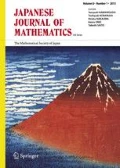Abstract.
We describe a setting where convergence to consensus in a population of autonomous agents can be formally addressed and prove some general results establishing conditions under which such convergence occurs. Both continuous and discrete time are considered and a number of particular examples, notably the way in which a population of animals move together, are considered as particular instances of our setting.
Similar content being viewed by others
References
R. Agaev and P. Chebotarev, On the spectra of nonsymmetric Laplacian matrices, Linear Algebra Appl., 399 (2005), 157–168.
Y. L. Chuang, Y. R. Huang, M. R. D’Orsogna and A. L. Bertozzi, Multi-vehicle flocking: Scalability of cooperative control algorithms using pairwise potentials, preprint, 2006.
F. Chung, Spectral Graph Theory, Amer. Math. Soc., Providence, RI., 1997.
F. Chung, Laplacians and the Cheeger inequality for directed graphs, Ann. Comb., 9 (2005), 1–19.
F. Cucker and S. Smale, Best choices for regularization parameters in learning theory, Found. Comput. Math., 2 (2002), 413–428.
F. Cucker and S. Smale, Emergent behavior in flocks, to appear at IEEE Trans. Automat. Control (2007).
F. Cucker, S. Smale and D. X. Zhou, Modeling language evolution, Found. Comput. Math., 4 (2004), 315–343.
G. Flierl, D. Grünbaum, S. Levin and D. Olson, From individuals to aggregations: The interplay between behavior and physics, J. Theoret. Biol., 196 (1999), 397–454.
M. Hirsch and S. Smale, Differential equations, dynamical systems, and linear algebra, Pure Appl. Math., 60, Academic Press, 1974.
A. Jadbabaie, J. Lin and A. S. Morse, Coordination of groups of mobile autonomous agents using nearest neighbor rules, IEEE Trans. Automat. Control, 48 (2003), 988–1001.
J. Ke, J. Minett, C.-P. Au and W. S.-Y. Wang, Self-organization and selection in the emergence of vocabulary, Complexity, 7 (2002), 41–54.
B. Mohar, The Laplacian spectrum of graphs, In: Graph Theory, Combinatorics, and Applications, (eds. Y. Alavi, G. Chartrand, O. R. Oellermann and A. J. Schwenk), 2, John Wiley & Sons, 1991, pp. 871–898.
P. Niyogi, The Computational Nature of Language Learning and Evolution, The MIT Press, 2006.
H. G. Tanner, A. Jadbabaie and G. J. Pappas, Stable flocking of mobile agents, Part I: Fixed topology, In: Proceedings of the 42nd IEEE Conference on Decision and Control, 2003, pp. 2010–2015.
H. G. Tanner, A. Jadbabaie and G. J. Pappas, Stable flocking of mobile agents, Part II: Dynamic topology, In: Proceedings of the 42nd IEEE Conference on Decision and Control, 2003, pp. 2016–2021.
C. M. Topaz, A. L. Bertozzi and M. A. Lewis, A nonlocal continuum model for biological aggregation, Bull. Math. Biol., 68 (2006), 1601–1623.
J. N. Tsitsiklis, Problems in decentralized decision making and computation, PhD thesis, Department of EECS, MIT, 1984.
J. N. Tsitsiklis, D. P. Bertsekas and M. Athans, Distributed asynchronous deterministic and stochastic gradient optimization algorithms, IEEE Trans. Automat. Control, 31 (1986), 803–812.
T. Vicsek, A. Czirók, E. Ben-Jacob and O. Shochet, Novel type of phase transition in a system of self-driven particles, Phys. Rev. Lett., 75 (1995), 1226–1229.
Author information
Authors and Affiliations
Corresponding author
Additional information
Communicated by: Toshiyuki Kobayashi
This article is based on the 1st Takagi Lectures that the second author delivered at Research Institute for Mathematical Sciences, Kyoto University on November 25 and 26, 2006.
Steve Smale Partially supported by an NSF grant.
About this article
Cite this article
Cucker, F., Smale, S. On the mathematics of emergence. Jpn. J. Math. 2, 197–227 (2007). https://doi.org/10.1007/s11537-007-0647-x
Received:
Accepted:
Published:
Issue Date:
DOI: https://doi.org/10.1007/s11537-007-0647-x




